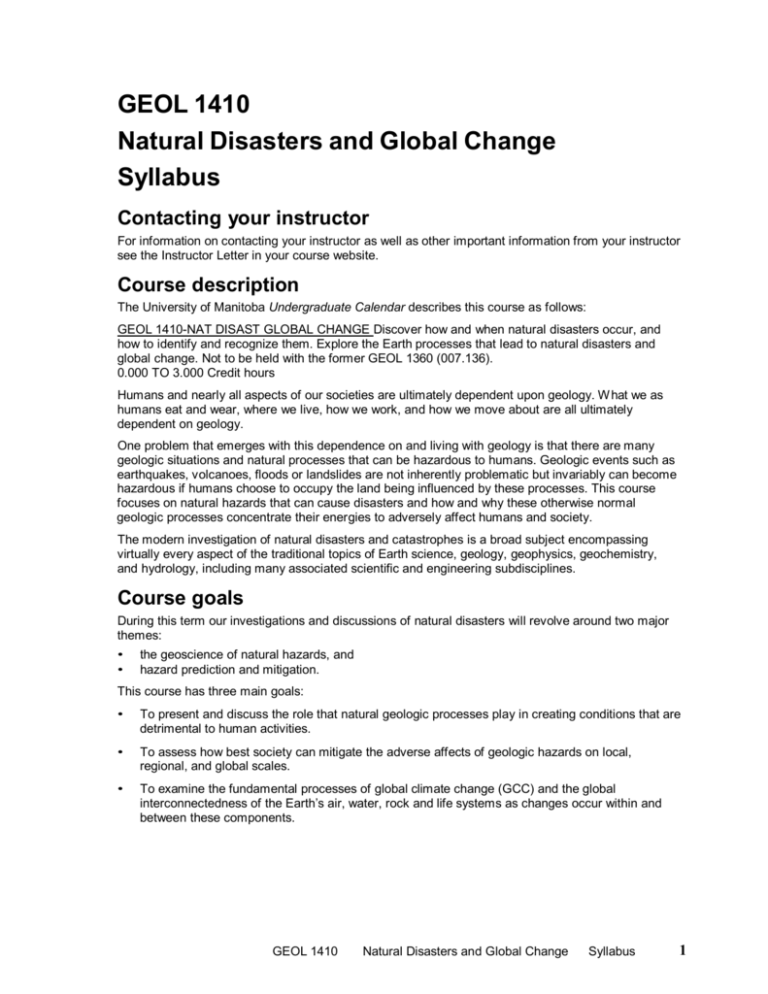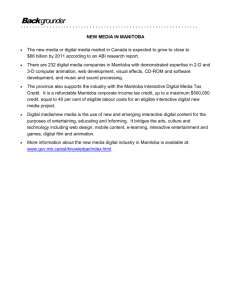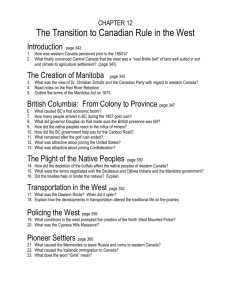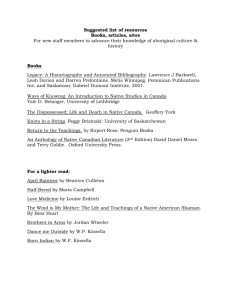
GEOL 1410
Natural Disasters and Global Change
Syllabus
Contacting your instructor
For information on contacting your instructor as well as other important information from your instructor
see the Instructor Letter in your course website.
Course description
The University of Manitoba Undergraduate Calendar describes this course as follows:
GEOL 1410-NAT DISAST GLOBAL CHANGE Discover how and when natural disasters occur, and
how to identify and recognize them. Explore the Earth processes that lead to natural disasters and
global change. Not to be held with the former GEOL 1360 (007.136).
0.000 TO 3.000 Credit hours
Humans and nearly all aspects of our societies are ultimately dependent upon geology. W hat we as
humans eat and wear, where we live, how we work, and how we move about are all ultimately
dependent on geology.
One problem that emerges with this dependence on and living with geology is that there are many
geologic situations and natural processes that can be hazardous to humans. Geologic events such as
earthquakes, volcanoes, floods or landslides are not inherently problematic but invariably can become
hazardous if humans choose to occupy the land being influenced by these processes. This course
focuses on natural hazards that can cause disasters and how and why these otherwise normal
geologic processes concentrate their energies to adversely affect humans and society.
The modern investigation of natural disasters and catastrophes is a broad subject encompassing
virtually every aspect of the traditional topics of Earth science, geology, geophysics, geochemistry,
and hydrology, including many associated scientific and engineering subdisciplines.
Course goals
During this term our investigations and discussions of natural disasters will revolve around two major
themes:
•
•
the geoscience of natural hazards, and
hazard prediction and mitigation.
This course has three main goals:
•
To present and discuss the role that natural geologic processes play in creating conditions that are
detrimental to human activities.
•
To assess how best society can mitigate the adverse affects of geologic hazards on local,
regional, and global scales.
•
To examine the fundamental processes of global climate change (GCC) and the global
interconnectedness of the Earth’s air, water, rock and life systems as changes occur within and
between these components.
GEOL 1410
Natural Disasters and Global Change
Syllabus
1
Course materials
Required
Bookstore
The following required materials are available for purchase from the University of Manitoba Bookstore.
Please order your materials immediately, if you have not already done so. See your Distance and
Online Education Student Handbook for instructions on how to order your materials.
Textbook
Keller, E. A., Blodgett, R. H., and Clague, J. J., (2012). Natural Hazards: Earth’s Processes as
nd
Hazards, Disasters, and Catastrophes (2 Canadian Edition), Pearson-Prentice Hall, Toronto.
Please note that in addition to the print version, the publisher offers an E-book version of this text (see
http://www.coursesmart.com/natural-hazards-earth-processes-as-hazards/edward-a-keller-robert-hblodgett-john-j/dp/9780135090541 )
Approximately 80% of this text will be assigned during the term.
Course overview
The course is intended to provide an overview of the salient aspects of geologic hazards as they
contribute to disasters, some of which are unique to the field, others being shared with allied
disciplines such as soil science, engineering geoscience, hydrology, and geochemistry. The ultimate
objective of the course is to foster your analytical and critical thinking skills. We will have plenty of
facts to learn, but we will always want to go beyond just the bare facts to the societal/environmental
implications and interpretations. It must also be emphasized that many of the hazards we will
systematically discuss as separate processes are actually strongly interconnected.
Learning activities
This online course will utilize the following learning activities:
•
•
•
•
•
Online notes
Textbook readings that supplement the online notes
Web links
Review questions
Written projects
Evaluation and grading
Grading scale
Letter grade
A+
A
B+
B
C+
C
D
F
Percentage range
90 – 100
80 – 89
75 – 79
70 – 74
65 – 69
60 – 64
50 – 59
49 and below
Description
Exceptional
Excellent
Very good
Good
Satisfactory
Adequate
Marginal
Failure
Please check the academic calendar for the last date for voluntary withdrawal from the course without
academic penalty. I am instructed by ROASS policy to advise you to read the academic regulations
and policies in the current years University Undergraduate Calendar. In particular, be aware of the
policies regarding academic dishonesty, including plagiarism and cheating, examination personation,
and attendance at class and debarment. In the case of individual assignments and term projects,
specific instructions concerning due dates are provided at the start of the term. If you have any
questions, ask.
2
Distribution of marks
Evaluation
Percentage
50%
50%
2 written projects @ 25%
Final examination
Total
100%
Late assignments and term projects will NOT be accepted.
Note: All final grades are subject to departmental review.
Assignments
Term projects
GEOL 1410 Natural Disasters and Global Change is designed to fulfill the University's "written
English"(W) requirement through the submission and evaluation of two significant written
assignments or term projects. Each of these projects is worth 25% of your total mark; each will be
evaluated and graded on the following criteria and weighting:
i.
Annotated bibliography (30%). An annotated bibliography is an alphabetical listing of sources
that are important or critical for your research project and that you will likely be using in your
paper. Each reference item must be listed in the required reference citation format and
includes a short paragraph or several sentences (“annotation”) that describe the usefulness of
the reference, its contribution and/or importance. The required citation format is outlined in the
course notes. Be sure to follow this format. Importantly, one of the main objectives of
preparing an annotated bibliography is to demonstrate that you have done the required
research on your project topic. As such, it should be as complete as possible. Indeed, often
the annotated bibliography list will be longer than the reference list that is actually submitted
as part of your paper.
ii.
Quality of writing and presentation (25%). This includes clarity of sentences and paragraphs,
organization and coherence of ideas, structuring, style, grammar, punctuation, use of English
and use of figures/tables.
iii.
Scientific content and information (20%).
iv.
References and use of references (25%). This includes the scholarly level and soundness of
the references, how effective the references are used and cited in the paper, and adherence
of correct format for citation and referencing. The REQUIRED reference citation format for
both of your projects (including the format for the references in your annotated bibliography) is
outlined in the course notes. You should NOT use any other referencing format.
It is expected that your papers are original. If a paper, or any part of a paper, is identified as not
being original, and/or not done by the student, the paper may receive a zero. Anything that is not
your own thoughts/concepts must be cited explicitly in the text. Every source you use must be cited
within the text of the final paper. The University of Manitoba has an exceptional Library system with
a large number of quality peer-reviewed scientific journals available both in-house and on-line. Use
of non-refereed, non-reviewed sources (including most 'encyclopedias') is generally not acceptable
in scientific writing at the university level. In particular, use of non-refereed on-line sources such
as ask.com, about.com, Wikipedia, etc. is not permitted for these projects.
The topics for the term projects are provided in the course notes. You should start working on these
projects soon; do not wait until the last minute to start the projects because they both demand a
considerable amount of research time. If you have not done a university-level term paper or a term
project write-up, it is recommended you contact the Writing Tutor Program of the Academic Learning
Centre (http://umanitoba.ca/student/academiclearning/).
GEOL 1410
Natural Disasters and Global Change
Syllabus
3
Your paper will need to be submitted digitally through the course website. Do not wait until the last
day to submit your paper because the system periodically goes down or there may be technical
issues which might result in your paper not being submitted on time. Late papers are not accepted
and will receive a mark of zero. Required style/format guidelines are posted on your course
website; please consult these and follow the guidelines closely, particularly with respect to
referencing and reference citation format.
BOTH assignments must be completed, and a minimum grade of 25 out of 50 on the assignments
achieved, along with a passing grade for the final examination, to achieve a passing grade for the
course. The mark on the first assignment will constitute written feed-back prior to the voluntary
withdrawal date for the course.
Final examination
Note: If you need to write the final exam at a location other than the University of Manitoba Campus,
please submit the “Application Form for Examination at a Location Other than the University of
Manitoba Campus” immediately.
At the end of the course an invigilated final examination will be written which will be worth 50% of your
final mark. This examination will be designed to test not only your grasp of the theoretical concepts of
hazard geoscience, but also the more practical critical evaluation and problem-solving abilities you have
acquired. Normally, the final examination is weighted approximately equally between material covered in
the course notes and that covered in the assigned textbook readings.
Plagiarism, cheating, and examination impersonation
You should acquaint yourself with the University’s policy on plagiarism, cheating, and examination
impersonation as detailed in the General Academic Regulations and Policy section of the University of
Manitoba Undergraduate Calendar. Note: These policies are also located in your Distance and Online
Education Student Handbook or you may refer to Student Affairs at http://www.umanitoba.ca/student.
Distance and Online Education (DE) Student Resources
In your course website there are links for the following:
•
•
•
Contact Distance and Online Education Staff
Distance and Online Student Handbook
Distance and Online Education Website
Acknowledgements
Content specialist:
William and Fawn Last
Geological Sciences
Faculty of Environment, Earth & Resources University of
Manitoba
Web developer:
Joy Wei
Distance and Online Education
University of Manitoba
Chris Cabildo
Distance and Online Education
University of Manitoba
Tara Smilinski
Distance and Online Education
University of Manitoba
Copyright © 2011, 2010. Revisions 2013, 2014.
All rights reserved. No part of the material protected by this copyright may be reproduced, stored in a retrieval system, or
transmitted in any form or by any means, electronic or mechanical, including photocopying, recording, or otherwise without the
prior written permission from the copyright owner.
The University of Manitoba, Distance and Online Education
4





